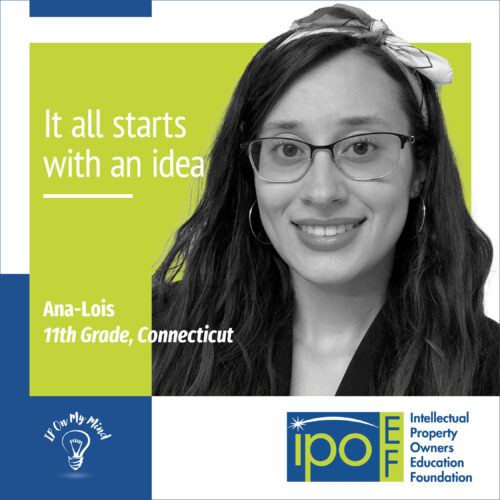
Intellectual Property Education Is Empowerment
Ana-Lois Davis
11th Grade, Connecticut

“I’m a bit old-fashioned,” says Ana-Lois Davis, laughing while describing the ways she protects her intellectual property (IP). The Connecticut 11th-grader’s signature hair bow, bright smile and curiosity reflect that her true youthful spirit is anything but old-fashioned – though the student does have drive and wisdom beyond her years. Davis is a serial inventor, having competed multiple times in the Connecticut Invention Convention and Invention Convention U.S. Nationals. Becoming an inventor at such a young age has helped Davis become a confident and conscientious engineer-in-the-making who strives to come up with creative solutions to life’s problems without stepping on the toes of the STEM leaders who came before her.
Davis first became invested in intellectual property (IP) after creating her first invention. She designed a device for drivers to clearly communicate that it’s safe to pass each other. She was invited to bring the invention to Invention Convention U.S. Nationals. While driving home from the competition, Davis was beaming with pride. She worked hard on her invention, competed on the national level and many people were so impressed with her invention that they asked to take pictures of it. Davis’ smile was everlasting… until her family drove past a car that had a similar communication device in the rear window. Davis was incredibly distraught that despite the extensive research she had done, her invention was not as original as she thought. In that moment, the young inventor realized how important intellectual property is. Had the individual that created the original driving communication device published more documentation of their creation or pursued IP ownership, Davis would have made changes to her invention to make it more original. Davis also realized that allowing people to take photos of her invention made her vulnerable to having her idea taken as well. The experience made Davis realize that she (and other young inventors) need to learn more about how to seriously protect intellectual property.
Most people say that “it all starts with an idea,” but, for Davis, inventing and creating intellectual property starts with a problem. “Anyone who is driven by solving problems is an inventor,” says Davis. Finding a solution to an issue in her personal life or in her community is a primary motivator for Davis, and one that helps her to come up with original ideas. Problem-solving is the core of Davis’ invention process – the product is secondary.
While problem-solving, Davis strives to be respectful of previous inventors who have already created solutions or current inventors who are working on solutions today. Focusing on solving a problem helps her avoid intellectual property infringements. An invention that already exists provides only one solution to a problem, but through finding a better, alternative solution, she creates an original idea.
After setting out to solve a problem, Davis then searches online and talks to as many people as she can to see if a solution has already been found. “It’s possible that your idea might already be out there, but if you’re really passionate about that idea, you can come up with a way to innovate it forward and improve it,” says Davis. Inventors can search for previous solutions through Google, but Davis recommends consulting a variety of sources, like academic journals, patent databases, networking with experts and even advertisements to see what other ideas have already been brought to the table.
Now, here’s where Davis’ “old-fashioned” practices become incredibly important. “I will get a blank sheet of paper and I’ll draw or write everything out,” explains Davis. “Every time that I note something on a piece of paper, before I walk away, I always write the date at the top and sign my name.” By signing and dating their notes, an inventor is establishing evidentiary support that their intellectual property is truly theirs. While anyone can have a passing thought about a potential invention, it’s a vital first-step in IP ownership to write that idea down and to document the date. As Davis puts it, “How do you date your thought first?” You can’t, but you can prove when you wrote an idea down.
Davis takes note of everything in her invention process: her own thoughts and ideas, previously-created solutions, inspirations and even setbacks. Documentation is not only helpful for intellectual property, but for remembering all steps you’ve been through as an inventor. “It’s worth it in the end, because if you stay organized with it, you’ll have tangible evidence of the lifespan of your project.”
For Davis, the invention-making process and the documentation habits that she utilizes has been a wonderful way for her to learn about and become invested in intellectual property. She emphatically recommends that hands-on experience as an easy and accessible way for teachers to introduce intellectual property to their students. “At first, I would think ugh, I have to sign all these papers and date everything and keep it in a nicely filed catalog,” Davis recalls, “But now I find it oddly satisfying, because at the end of the year, I can look back and see all the progress I’ve made and all the changes that my idea has gone through. It’s really fulfilling.”




